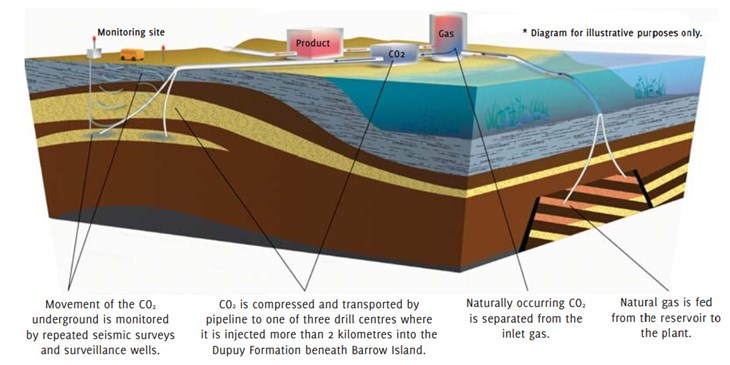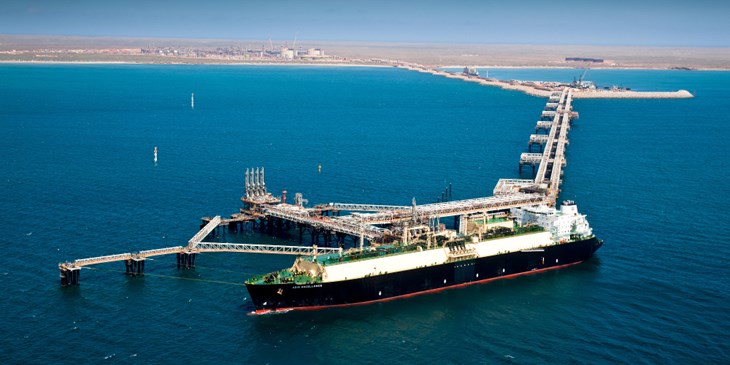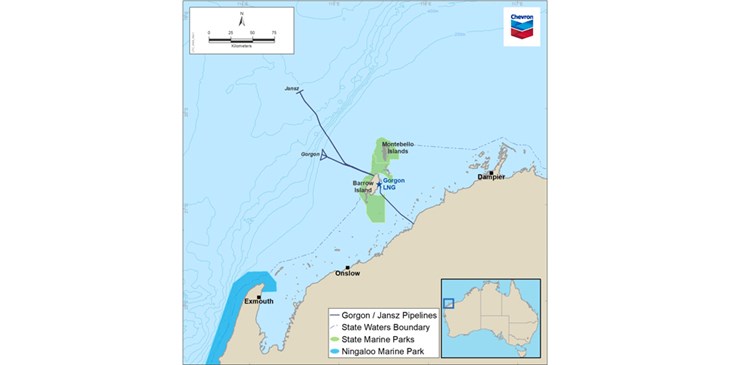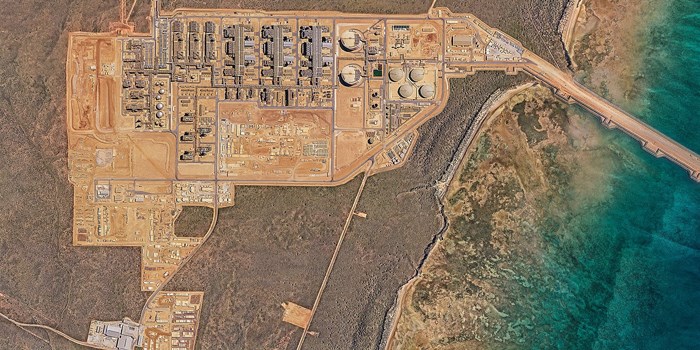^ Satellite image of the Gorgon Project
Article by Daniel Sweet
___
Chevron’s Gorgon Project is one of the world’s largest natural gas ventures: an LNG operation in Australia, with the main production facility located on Barrow Island off the northwest coast.
The Barrow Island facility includes an LNG plant with three processing units designed to produce 15.6 million metric tons every year. In 2018, the total daily production rates averaged between 2.6 billion cubic feet of natural gas and 18,000 barrels of condensate.
The Gorgon Project has been under active development since 2010 and features several high-tech solutions, including a carbon capture and storage (CCS) injection site designed to reduce the project’s greenhouse gas emissions.
World’s largest carbon emitter
In traditional gas processing operations, the bulk of unwanted CO2 is vented into the atmosphere after collection. As CO2 represents the majority of the earth’s greenhouse gases, this practice has severe consequences for the environment.According to Reuters, Australia is the world’s largest carbon emitter per capita, emitting 538.2 million tons of CO2 equivalent in 2018, up 0.7 per cent from the previous year, mainly due to increased LNG exports.
Before its implementation of CCS, Chevron’s Gorgon Project was the biggest emitter of carbon across all of Australia’s 10 LNG facilities.
But in August 2019, Chevron began depositing CO2 deep underground—some 2.5km below Barrow Island. Their CCS injection facility should help reduce greenhouse gas emissions associated with the Gorgon Project by approximately 40 per cent, or more than 100 million tons over the life of the injection project.

Turbidite sand deposit
According to Chevron, the gas in the Gorgon Field contains on average 14 per cent naturally occurring CO2. This CO2 is collected during the first stages of the production process but is quickly separated from the natural gas stream before liquefaction. If CO2 remained in the stream during the liquefaction stage, when the natural gas is cooled to -162° C, it would freeze into a solid.While standard industry practice is to vent the separated CO2 into the atmosphere, the Gorgon Project will inject the CO2 into a massive turbidite sand deposit beneath Barrow Island. The CO2 will be separated at the LNG plant site and transported by pipeline to one of three drill centres.
Lowest CO2 emitter in Australia
“To minimise the environmental footprint on the island, nine injection wells have been directionally drilled from the three drill centres. Once the CO2 is injected, it will migrate through the formation until it becomes trapped. An on-going monitoring program, which includes observation wells and seismic surveys, will assist in managing the performance of the injected CO2,” according to Chevron’s website.
Chevron anticipates that as a result of CCS technology, Gorgon will have the lowest greenhouse gas emissions intensity of any LNG project in Australia.
As explained by the Carbon Capture and Storage Association, CCS technology “can capture up to 90 per cent of the CO2 emissions produced from industrial processes,” including natural gas processing. The technology has been in use since 1972, notably at the Terrell Natural Gas Processing Plant in Texas, the oldest operating industrial CCS project in the world.

Source of optimism
The Journal of Petroleum Technology reports that “there are currently 23 large-scale CCS facilities in operation or under construction around the world, according to the Global Carbon Capture and Storage Institute (GCCSI), capturing almost 40 Mtpa of CO2. An additional 28 pilot and demonstration-scale facilities in operation or under construction collectively capture another 3+ Mtpa.”
The increasing capacity for CCS is a source of optimism for those who realise its potential to curb the effects of climate change, as a significant reduction in carbon emissions is needed to achieve international climate goals.

Negative net-emissions
According to The Journal of Petroleum Technology, it is possible for CCS, when combined with biomass, to result in net negative emissions. “A trial of bio-energy with carbon capture and storage (BECCS) at a wood-fired unit at the Drax power station in the UK started in 2019. If successful, this project could remove a tiny amount of CO2 from the atmosphere.”
Effectiveness
Many commentators have suggested that without the widespread adoption of CCS, it will be challenging to reduce the effects of climate change. The International Energy Agency maintains “that to reach Paris climate targets by 2060, 14 per cent of cumulative emission reductions must derive from CCS.”
Furthermore, the Intergovernmental Panel on Climate Change confirms that “CCS is the only mitigation technology able to decarbonise large industrial sectors,” particularly the petrochemical industry.
One common objection to CCS technology regards the effectiveness of storage underground. But according to the Global CSS Institute, “industrial-scale, pilot, and research-scale storage projects inject several millions of tons of CO2 annually into deep saline formations, demonstrating that injection is safe and effective. EOR (Enhanced Oil Recovery)-projects, where CO2 storage occurs incidentally, have been operating safely for decades.”


